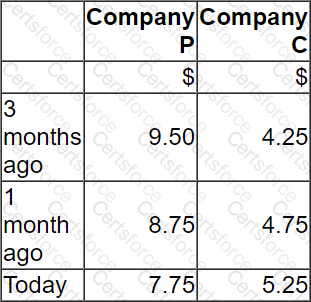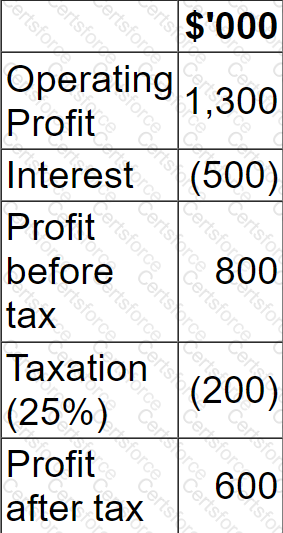Company XXY operates in country X with the X$ as its currency. It is looking to acquire company ZZY which operates in country Z with the Z$ as its currency.
The assistant accountant at Company XXY has started to prepare an initial valuation of Company ZZY's equity for the first 3 years, however their valuation is incomplete. TBC' in the table below indicates that her calculations have yet to be completed.

The following information is relevant:

What is the correct figure (to the nearest million S) to include in year 3 as the present value in X$ million?
A company needs to raise $20 million to finance a project.
It has decided on a rights issue at a discount of 20% to its current market share price.
There are currently 20 million shares in issue with a nominal value of $1 and a market price of $5 per share.
Calculate the terms of the rights issue.
Company MB is in negotiations to acquire the entire share capital of Company BBA. Information about each company is as follows:

It is expected that Company BBA's profit before interest and tax will be $30 million in each of the two years after acquisition. Company AAB is considering how best to structure the offer Company AAB's discount factor and appropriate cost of equity for use in valuing Company BBA is 10%
Shareholders taxation implications should be ignored
Which of the following provides the shareholders of Company BBA with the highest offer price?
A company plans a four-year project which will be financed by either an operating lease or a bank loan.
Lease details:
• Four year lease contract.
• Annual lease rentals of $45,000, paid in advance on the 1st day of the year.
Other information:
• The interest rate payable on the bank borrowing is 10%.
• The capital cost of the project is $200,000 which would have to be paid at the beginning of the first year.
• A salvage or residual value of $100,000 is estimated at the end of the project's life.
• Purchased assets attract straight line tax depreciation allowances.
• Corporate income tax is 20% and is payable at the end of the year following the year to which it relates.
A lease-or-buy appraisal is shown below:

Which THREE of the following items are errors within the appraisal?
MAN is a manufacturing company that is based in country M and sells almost exclusively to customers in country M, priced in the local currency, M$.
MAN wishes to expand the business by acquiring a company that manufactures similar products but has a more global customer base. It is particularly interested in selling to customers in country P, which uses currency P$ but recognises that the P$ is generally quite volatile against the M$.
Country P uses the same language as country M, has free entry of labour from country M, no exchange controls or withholding tax and a favourable double tax treaty.
Which of the following companies would be most suitable takeover candidates for MAN to investigate further?
Company A plans to acquire Company B.
Both firms operate as wholesalers in the fashion industry, supplying a wide range of ladies' clothing shops.
Company A sources mainly from the UK, Company B imports most of its supplies from low-income overseas countries.
Significant synergies are expected in management costs and warehousing, and in economies of bulk purchasing.
Which of the following is likely to be the single most important issue facing Company A in post-merger integration?
A listed company in a high growth industry, where innovation is a key driver of success has always operated a residual dividend policy, resulting in volatility in dividends due to periodic significant investments in research and development.
The company has recently come under pressure from some investors to change its dividend policy so that shareholders receive a consistent growing dividend. In addition, they suggested that the company should use more debt finance.
If the suggested change is made to the financial policies, which THREE of the following statements are true?
Company C has received an unwelcome takeover bid from Company P.
Company P is approximately twice the size of Company C based on market capitalisation.
Although the two companies have some common business interests, the main aim of the bid is diversification for Company P.
The offer from Company P is a share exchange of 2 shares in Company P for 3 shares in Company C.
There is a cash alternative of $5.50 for each Company C share.
Company C has substantial cash balances which the directors were planning to use to fund an acquisition.
These plans have not been announced to the market.
The following share price information is relevant. All prices are in $.

Which of the following would be the most appropriate action by Company C's directors following receipt of this hostile bid?
A company has forecast the following results for the next financial year:
The following is also relevant:
• Profit after tax for the year can be assumed to be equivalent to free cash flow for the year.
• Debt finance comprises a $10 million floating rate loan which currently carries an interest rate of 5%.
• $400,000 investment in non-current assets is required to achieve required growth, all of which is to financed from next year's free cash flow.
• The company plans to pay a dividend of $150,000 next year, financed from next year's free cash flow.
The company is concerned that interest rates could rise next year to 6% which could then affect their investment plans.

If interest rates were to rise to 6% and the company wishes to maintain its dividend amount, the planned investment expenditure will decrease by:
A profitable company wishes to dispose of a loss-making division that generated negative free cashflow in the last financial year.
The division requires significant new investment to return it to profitability.
Which of the following valuation approaches is likely to be the most useful to the company when negotiating the sales price?